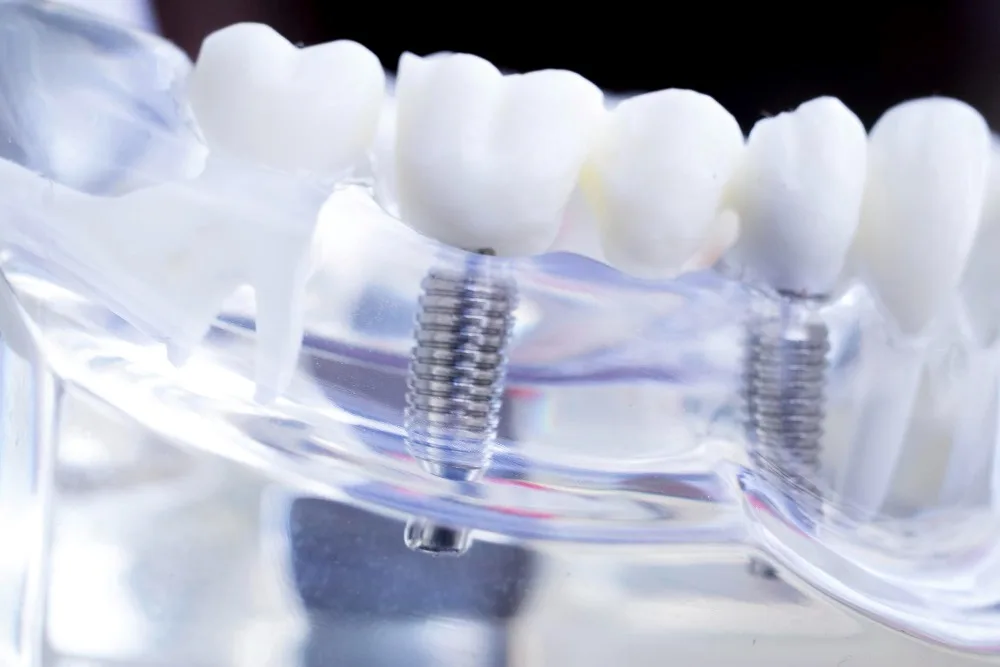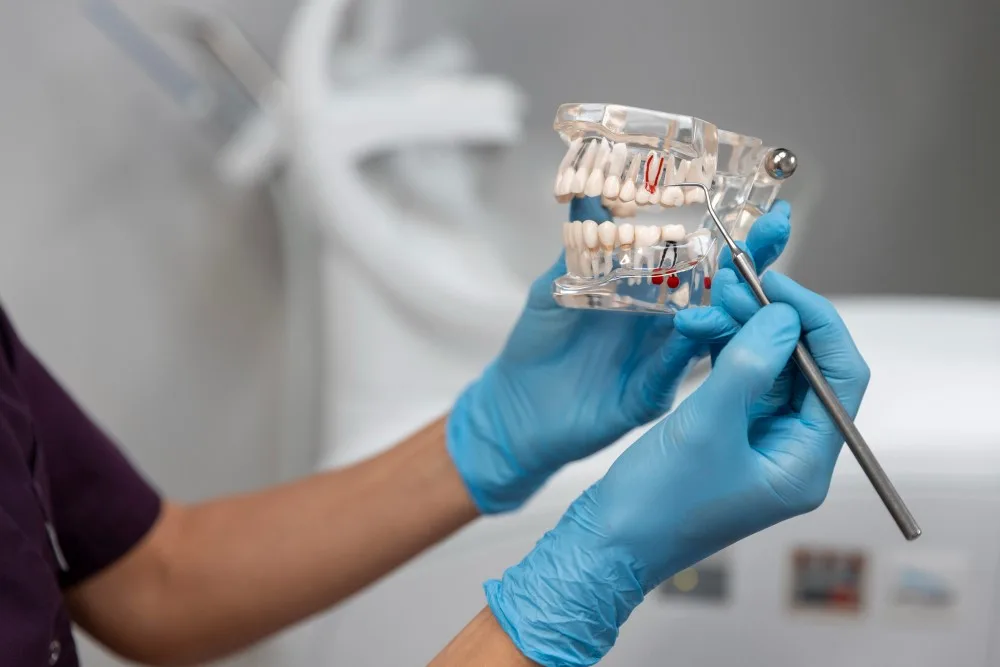Subperiosteal Implant: A Solution for Severe Bone Loss
A subperiosteal implant offers a specialized solution for patients who are not candidates for conventional dental implants due to severe bone loss in the jaw. Unlike traditional implants that are placed into the bone, a subperiosteal implant sits on top of the jawbone but beneath the gum tissue, supported by a custom-designed metal framework.
This type of implant is especially helpful for individuals who are unable or unwilling to undergo bone grafting procedures. It offers a stable foundation for fixed or removable prosthetic teeth in cases where bone volume is insufficient for standard implants.
While subperiosteal implants were once considered outdated, modern imaging technology and CAD/CAM design have led to a resurgence in their precision, comfort, and predictability. In this guide, we’ll explore what they are, when they’re used, how they’re placed, and whether they might be the right fit for complex dental cases.
Subperiosteal Implant: What It Is and Who Needs It
A subperiosteal implant is a custom-fitted metal framework that sits directly on top of the jawbone, under the periosteum (the tissue layer that covers the bone). The frame includes posts that protrude through the gums and serve as anchors for a dental prosthesis.
This type of implant is primarily used for patients with extensive bone loss who cannot support conventional endosteal implants, which are surgically placed into the bone itself. Subperiosteal implants bypass the need for grafting by using the surface of the bone for support.
Patients who have worn removable dentures for many years often experience progressive bone resorption. When bone density is too low for traditional implants, a subperiosteal implant can provide an effective and permanent alternative.
Thanks to digital imaging and 3D printing technologies, modern subperiosteal frameworks are now custom-made to fit the unique contours of a patient’s jaw. This not only improves surgical precision but also enhances long-term comfort and success.
Subperiosteal Implant vs Endosteal Implant: Key Differences
The main difference between a subperiosteal implant and an endosteal implant lies in how and where each is placed in the jaw. Endosteal implants are the most common type and are surgically inserted into the jawbone. They resemble screws or cylinders and require sufficient bone volume for stability.
In contrast, a subperiosteal implant rests on top of the jawbone but underneath the gum tissue. It does not integrate with the bone in the same way as endosteal implants but instead uses a framework to support the prosthesis.
The key advantage of subperiosteal implants is that they can be used in patients with significant bone loss—especially those who are not good candidates for bone grafting procedures. While endosteal implants require healing time for osseointegration, subperiosteal implants are sometimes placed in a single procedure, reducing treatment duration in select cases.
However, endosteal implants are generally preferred when adequate bone is present because they have higher long-term success rates and simpler maintenance. Subperiosteal implants are typically considered in more complex or advanced cases.
Understanding the anatomical and procedural distinctions between these two types of implants helps guide appropriate treatment decisions based on a patient’s oral health, jaw structure, and preferences.
How Subperiosteal Implants Are Designed and Placed
The process of designing and placing a subperiosteal implant begins with a detailed assessment of the patient’s oral and bone anatomy. Advanced imaging techniques such as CBCT (cone beam computed tomography) are used to create a 3D model of the jaw. This model allows for the custom design of a metal framework that will precisely conform to the bone surface.
The design phase is critical. The subperiosteal implant must contour the bone and include vertical posts that will emerge through the gums to support the prosthetic teeth. CAD/CAM technology ensures that the fit is accurate, which helps reduce surgical time and complications.
Placement involves a surgical procedure where the gums are opened to expose the bone. The custom framework is fitted directly over the jawbone and secured in place. Once positioned, the gum tissue is closed around the posts. In many cases, temporary prosthetics can be attached shortly after surgery.
Recovery involves a short healing period, during which the gums adapt to the new structure. The final prosthetic can be installed once the area is stable. Because there is no need for bone grafting or waiting for osseointegration, the overall timeline may be shorter than with traditional implant treatments.
When Subperiosteal Implants Are Recommended: Bone Loss and Alternatives
Subperiosteal implants are typically recommended in cases where severe bone loss in the upper or lower jaw makes traditional endosteal implants unviable. This kind of bone resorption is common in patients who have been without teeth for many years, particularly those who have worn full dentures that no longer fit securely.
Unlike bone grafts, which require additional surgery and months of healing time, subperiosteal implants can offer a faster and less invasive path to implant-supported restorations. For patients with medical conditions that rule out bone grafting or for those seeking quicker results, this implant option may be a valuable alternative.
These implants may also be considered when the sinus cavity in the upper jaw is too close to the ridge to allow for standard implant placement, and sinus lift procedures are not viable or preferred.
While zygomatic implants are another option for patients with severe bone loss in the upper jaw, they are more invasive and require placement into the cheekbone. Subperiosteal implants provide a less extreme alternative in select cases.
Ultimately, choosing a subperiosteal implant depends on bone volume, health history, and patient goals. A consultation with a specialist in complex implantology is essential to determine whether this approach is appropriate.
Step‑by‑Step Subperiosteal Implant Surgery: What to Expect

Subperiosteal implant surgery begins with a detailed diagnostic phase. The dentist or oral surgeon uses digital scans, such as CBCT, to capture the exact dimensions of the jawbone. These images are then used to create a custom metal framework designed to rest directly on the surface of the bone beneath the gums.
On the day of surgery, the patient receives local anesthesia or sedation. The gums are carefully opened to expose the jawbone, and the custom-designed subperiosteal implant is positioned to fit the bone contours. The framework is secured using mechanical contact or mini-screws in some cases, and the posts extend through the gums to support a future prosthesis.
Once the framework is seated correctly, the gum tissue is sutured back around the protruding posts. Healing typically takes a few weeks, during which temporary teeth may be placed depending on the case. The permanent prosthesis is installed once the area is stable and the tissue has adapted to the new structure.
Recovery is generally faster than with bone grafting or multi-stage implant procedures. Patients may experience mild swelling or discomfort, which is manageable with prescribed medication. Follow-up appointments are crucial to monitor healing and ensure the fit of the final prosthetic.
Subperiosteal implant surgery is complex but can be life-changing for patients with advanced bone loss. The key to success is personalized planning, surgical precision, and good post-operative care.
Material Options for Subperiosteal Implants: Titanium Frames and CAD/CAM Design
Modern subperiosteal implants are typically made from titanium or titanium alloys, which offer a unique combination of strength, biocompatibility, and lightweight properties. Titanium is widely accepted by the human body and integrates well with soft tissues, reducing the risk of rejection or adverse reactions.
The framework of the implant is fabricated using CAD/CAM technology. Digital scans of the jaw allow technicians to create a precise virtual model, which is then used to machine a customized frame that matches the exact topography of the bone. This level of precision minimizes surgical trauma and ensures a snug, stable fit.
Titanium frames can be either cast or milled. Milled titanium, created from a solid block using computer-controlled equipment, provides exceptional accuracy and durability. This approach is now the standard in advanced implant clinics and hospitals offering custom prosthetic solutions.
In addition to titanium, some older systems may use cobalt-chrome alloys, but these are less common due to their heavier weight and less favorable tissue response. Emerging technologies may also incorporate 3D-printed designs using biocompatible materials.
The quality and fit of the subperiosteal implant frame directly influence comfort, healing time, and prosthetic stability. Choosing a provider who uses advanced digital planning and high-quality materials is essential for long-term success.
How Much Does a Subperiosteal Implant Cost? Factors That Affect Price
The cost of a subperiosteal implant can vary widely depending on the complexity of the case, the materials used, the geographic location of the clinic, and the experience of the surgical team. Because these implants are custom-designed and typically used in advanced bone loss cases, they are often more expensive than traditional implants.
One of the main cost drivers is the imaging and design process. CBCT scans, digital impressions, and CAD/CAM fabrication of the titanium framework require advanced equipment and skilled technicians. Additionally, subperiosteal implant surgery is more specialized and may involve collaboration between a prosthodontist and an oral or maxillofacial surgeon.
Laboratory fees, surgical facility use, and anesthesia may also add to the total cost. Some treatment plans may include temporary and permanent prostheses, which are billed separately from the implant itself.
In general, the cost of a subperiosteal implant may be comparable to or slightly higher than the combined cost of bone grafting and conventional implant placement. However, it often requires fewer surgeries and less treatment time overall, which can make it more cost-efficient for suitable candidates.
Because pricing can range significantly, a detailed consultation and treatment plan are necessary to determine the final expense. Many providers offer payment plans or financing options to help patients manage the investment over time.
Subperiosteal Implant vs Bone Graft plus Endosteal Implant: Cost Comparison
For patients with severe bone loss, there are typically two main treatment paths: a subperiosteal implant or a bone graft followed by traditional endosteal implants. While both approaches aim to restore function and stability, they differ in complexity, cost structure, and overall timeline.
Bone grafting adds a preparatory phase to treatment. The patient may need autogenous grafts, allografts, or synthetic materials to rebuild bone volume over several months. This step increases treatment duration and costs, especially if sinus lifts or ridge augmentation is required.
Once healing is complete, endosteal implants are placed into the regenerated bone. This two-phase process involves more clinical visits, longer healing, and more materials. The cumulative cost of grafting and implants may exceed that of a subperiosteal implant—particularly when factoring in temporary restorations and follow-up procedures.
In contrast, a subperiosteal implant bypasses bone grafting altogether. The surgery is completed in a single stage in many cases, reducing total time in treatment. Although the implant itself is custom-made and carries higher lab costs, the simplified surgical timeline can offset some of that expense.
Patients and providers must weigh the financial and medical implications of each option. While subperiosteal implants may be more economical in complex bone-loss cases, bone grafting followed by endosteal placement may offer better long-term stability for certain anatomical profiles.
Insurance Coverage and Financing Options for Subperiosteal Implants
Insurance coverage for a subperiosteal implant depends heavily on the patient’s provider and the reason for treatment. Most dental insurance plans classify implants as elective or partially cosmetic procedures, meaning full coverage is unlikely. However, if the implant is deemed medically necessary—for example, due to trauma, congenital defects, or functional rehabilitation—partial reimbursement may be available.
Some plans may cover parts of the process, such as diagnostic imaging, extractions, or prosthetic components. Pre-authorization is often required, and detailed documentation from the dental provider is essential to justify the medical need.
For patients without insurance support, many clinics offer third-party financing options. These include monthly payment plans, medical credit lines like CareCredit, or in-house financing tailored to individual budgets. Some hospitals and dental schools may provide lower-cost treatment as part of residency training or research programs.
In countries with public healthcare systems, implant coverage varies depending on national policy. Subperiosteal implants are less likely to be covered unless no other alternative is clinically feasible.
Before starting treatment, it’s important to review all potential costs and explore available financial resources. A written treatment plan outlining each phase, including fees for surgery, lab work, prosthetics, and follow-ups, will help you make informed decisions.
How Long Do Subperiosteal Implants Last? Maintenance and Life Expectancy
A well-planned and properly placed subperiosteal implant can last many years, often a decade or more, depending on the patient’s health, oral hygiene, and prosthetic care. While they don’t osseointegrate like endosteal implants, subperiosteal frameworks are designed to conform closely to the bone’s surface, providing long-term mechanical stability.
The longevity of the implant largely depends on the accuracy of the surgical placement and the quality of the materials used—especially the custom titanium framework. Advances in digital imaging and CAD/CAM design have improved long-term outcomes significantly in recent years.
Post-operative care plays a crucial role. Patients must maintain excellent oral hygiene to prevent inflammation around the implant posts. Regular dental checkups are essential to monitor the condition of the gums and prosthetic components. Any loosening or irritation should be addressed early to prevent more serious complications.
Most complications arise from neglect, improper oral care, or underlying medical conditions that affect healing or immune response. However, with proper planning and maintenance, subperiosteal implants remain a stable and functional solution for patients with limited bone support.
Potential Risks and Complications of Subperiosteal Implants

Like all surgical procedures, subperiosteal implant placement carries certain risks. One of the more common issues involves soft tissue irritation, as the metal framework sits beneath the gums. If the posts or edges are improperly contoured, they may cause pressure, inflammation, or discomfort.
Infections can occur post-operatively, particularly if hygiene is compromised or healing is disrupted. Prompt care and antibiotics usually resolve these issues, but severe infections could lead to early failure of the implant.
Another complication involves movement or loosening of the framework over time. This could result from poor bone contact, insufficient design precision, or jawbone resorption. In such cases, re-evaluation or surgical adjustment may be required.
Tissue overgrowth around the posts can also interfere with prosthetic placement. Regular monitoring helps detect these problems before they compromise functionality.
Although rare, allergic reactions to the metals used in the implant frame are possible. Titanium is generally well-tolerated, but patients with metal sensitivities should be screened prior to surgery.
When placed by experienced clinicians using modern techniques, subperiosteal implants are safe and predictable. Understanding the potential risks allows patients to approach the procedure with realistic expectations and a proactive care plan.
What to Do If a Subperiosteal Implant Fails or Needs Adjustment
While subperiosteal implants have high success rates, failures can occur due to infection, structural fatigue, improper placement, or poor maintenance. Early detection is key to salvaging the situation and preventing more extensive damage.
Signs of failure may include persistent pain, gum swelling, loosening of the prosthesis, or mobility of the implant posts. If these symptoms occur, prompt evaluation by a dental professional is essential.
Minor issues can often be corrected with soft tissue adjustments, improved hygiene, or replacement of the prosthetic crown. In cases of framework instability, a surgical revision may be necessary to reposition or modify the implant.
When a subperiosteal implant cannot be salvaged, removal and reassessment of the jawbone may be required. Some patients may then transition to alternative implant strategies if sufficient healing occurs, or switch to removable prosthetics.
Preventing failure is always preferable. Regular dental visits, proper home care, and avoiding trauma to the implant area are critical to long-term success. Many complications are manageable if addressed early and professionally.
It might interest you –> Over Denture Implants
Comparing Subperiosteal Implants to Zygomatic and All‑on‑4 Solutions
Subperiosteal implants are one of several options for patients with severe jawbone loss. Other alternatives include zygomatic implants and the All‑on‑4 technique. Understanding how these methods compare helps guide informed treatment choices.
Zygomatic implants are extra-long posts that anchor into the cheekbone (zygoma) rather than the jawbone. They’re typically used for patients with extreme upper jaw bone loss. While they offer strong anchorage, placement is complex, invasive, and limited to specialized clinics.
The All‑on‑4 concept involves placing four strategically angled endosteal implants—often in areas with sufficient bone—to support a full arch of teeth. It avoids extensive grafting but still requires a minimum level of jawbone volume, which not all patients have.
A subperiosteal implant offers a less invasive alternative in many of these cases. It avoids deep drilling or zygomatic placement and does not rely on existing bone height. This makes it ideal for patients who can’t tolerate long surgeries or who prefer a graft-free solution.
Each option comes with trade-offs in cost, complexity, and long-term performance. The ideal choice depends on the patient’s anatomy, health history, and priorities regarding aesthetics, function, and recovery time.
For your information –> Straumann Implants
Future Directions: Advancements in Subperiosteal Implant Technology
Recent advancements in imaging, digital planning, and material science are redefining the possibilities for subperiosteal implant treatment. What was once considered a last resort for complex cases is now gaining renewed interest due to its precision and efficiency.
One major breakthrough is the use of CBCT-based 3D models combined with CAD/CAM technology to fabricate personalized titanium frameworks. This eliminates guesswork, reduces surgical time, and improves fit, resulting in better long-term outcomes.
Another development is the integration of 3D printing in frame production. Using medical-grade titanium or titanium alloys, these custom components are milled or printed to match the patient’s exact bone contours. As a result, modern subperiosteal implants are lighter, more accurate, and more biocompatible than older cast versions.
In terms of surgery, minimally invasive techniques and enhanced anesthetic options are making the procedure safer and more accessible. New surface coatings and antibacterial modifications are also being explored to improve tissue integration and reduce infection risk.
As patient demand grows for graft-free implant solutions with faster recovery, subperiosteal implants may become more mainstream—especially in digitally equipped clinics offering complex rehabilitation services.
The future points toward better customization, safer procedures, and expanded access for patients who would otherwise go without implant-based restorations.
Click and learn –> Dental Implants Turkey

